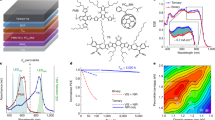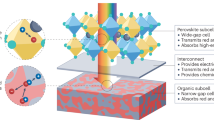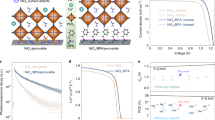Abstract
The broad bandgap tunability of both perovskites and organic semiconductors enables the development of perovskite–organic tandem solar cells with promising theoretical efficiency. However, the certified efficiencies of reported perovskite–organic tandem solar cells remain lower than those of single-junction perovskite solar cells, primarily because of insufficient near-infrared photocurrent in narrow-bandgap organic subcells1,2,3. Here we design and synthesize an asymmetric non-fullerene acceptor (NFA), P2EH-1V, featuring a unilateral conjugated π-bridge to reduce the optical bandgap to 1.27 eV while maintaining ideal exciton dissociation and nanomorphology. Transient absorption spectroscopy confirms efficient hole transfer from P2EH-1V to the donor PM6. Devices based on P2EH-1V exhibit reduced non-radiative voltage losses of 0.20 eV without compromising charge-generation efficiency. We achieve a 17.9% efficiency for the organic bottom cell, with a high short-circuit current density (Jsc) of 28.60 mA cm−2. Furthermore, we minimize interface recombination losses, enabling the perovskite top cell to achieve an impressive open-circuit voltage (Voc) of 1.37 V and a fill factor (FF) of 85.5%. These advancements result in perovskite–organic tandem solar cells achieving a record efficiency of 26.7% (certified at 26.4%) over an aperture area greater than 1 cm2.
This is a preview of subscription content, access via your institution
Access options
Access Nature and 54 other Nature Portfolio journals
Get Nature+, our best-value online-access subscription
$32.99 / 30 days
cancel any time
Subscribe to this journal
Receive 51 print issues and online access
$199.00 per year
only $3.90 per issue
Buy this article
- Purchase on SpringerLink
- Instant access to full article PDF
Prices may be subject to local taxes which are calculated during checkout




Similar content being viewed by others
Data availability
The data that support the findings of this study are available from the corresponding author on request.
References
Brinkmann, K. O. et al. Perovskite–organic tandem solar cells. Nat. Rev. Mater. 9, 202–217 (2024).
Brinkmann, K. O. et al. Perovskite–organic tandem solar cells with indium oxide interconnect. Nature 604, 280–286 (2022).
Chen, W. et al. Monolithic perovskite/organic tandem solar cells with 23.6% efficiency enabled by reduced voltage losses and optimized interconnecting layer. Nat. Energy 7, 229–237 (2022).
Lin, Y. et al. An electron acceptor challenging fullerenes for efficient polymer solar cells. Adv. Mater. 27, 1170–1174 (2015).
Meng, L. et al. Organic and solution-processed tandem solar cells with 17.3% efficiency. Science 361, 1094–1098 (2018).
Chen, W. et al. A semitransparent inorganic perovskite film for overcoming ultraviolet light instability of organic solar cells and achieving 14.03% efficiency. Adv. Mater. 30, 1800855 (2018).
Zhang, Z. et al. Suppression of phase segregation in wide-bandgap perovskites with thiocyanate ions for perovskite/organic tandems with 25.06% efficiency. Nat. Energy 9, 592–601 (2024).
Chen, X. et al. Efficient and reproducible monolithic perovskite/organic tandem solar cells with low-loss interconnecting layers. Joule 4, 1594–1606 (2020).
Wang, X. et al. Highly efficient perovskite/organic tandem solar cells enabled by mixed-cation surface modulation. Adv. Mater. 35, 2305946 (2023).
Ho-Baillie, A. W. Y. et al. Recent progress and future prospects of perovskite tandem solar cells. Appl. Phys. Rev. 8, 041307 (2021).
Jiang, X. et al. Isomeric diammonium passivation for perovskite–organic tandem solar cells. Nature 635, 860–866 (2024).
Chen, H. et al. Improved charge extraction in inverted perovskite solar cells with dual-site-binding ligands. Science 384, 189–193 (2024).
Wang, Y. et al. Homogenized contact in all-perovskite tandems using tailored 2D perovskite. Nature 635, 867–873 (2024).
Jost, M. et al. Perovskite/CIGS tandem solar cells: from certified 24.2% toward 30% and beyond. ACS Energy Lett. 7, 1298–1307 (2022).
He, Z. et al. Minimized optical/electrical energy loss for 25.1% monolithic perovskite/organic tandem solar cells. Nat. Commun. 16, 1773 (2025).
Wu, S., Liu, M. & Jen, A. K. Y. Prospects and challenges for perovskite–organic tandem solar cells. Joule 7, 484–502 (2023).
Yuan, J. et al. Single-junction organic solar cell with over 15% efficiency using fused-ring acceptor with electron-deficient core. Joule 3, 1140–1151 (2019).
Leijtens, T. et al. Opportunities and challenges for tandem solar cells using metal halide perovskite semiconductors. Nat. Energy 3, 828–838 (2018).
Wang, J. et al. The principles, design and applications of fused-ring electron acceptors. Nat. Rev. Chem. 6, 614–634 (2022).
Cheng, P. & Yang, Y. Narrowing the band gap: the key to high-performance organic photovoltaics. Acc. Chem. Res. 53, 1218–1228 (2020).
Liu, W. et al. Design of near-infrared nonfullerene acceptor with ultralow nonradiative voltage loss for high-performance semitransparent ternary organic solar cells. Angew. Chem. Int. Ed. 61, e202116111 (2022).
Jia, Z. et al. High performance tandem organic solar cells via a strongly infrared-absorbing narrow bandgap acceptor. Nat. Commun. 12, 178 (2021).
Chen, Z. et al. Ultrafast energy transfer from polymer donors facilitating spectral uniform photocurrent generation and low energy loss in high-efficiency nonfullerene organic solar cells. Energy Environ. Sci. 16, 3373–3380 (2023).
Sun, C. et al. Achieving fast charge separation and low nonradiative recombination loss by rational fluorination for high-efficiency polymer solar cells. Adv. Mater. 31, 1905480 (2019).
Liu, Y. et al. Recent progress in organic solar cells (Part I material science). Sci. China Chem. 65, 224–268 (2022).
Yi, J. et al. Advantages, challenges and molecular design of different material types used in organic solar cells. Nat. Rev. Mater. 9, 46–62 (2024).
Jia, Z. et al. Near-infrared absorbing acceptor with suppressed triplet exciton generation enabling high performance tandem organic solar cells. Nat. Commun. 14, 1236 (2023).
Qin, S. et al. Constructing monolithic perovskite/organic tandem solar cell with efficiency of 22.0% via reduced open-circuit voltage loss and broadened absorption spectra. Adv. Mater. 34, 2108829 (2022).
Zhang, J. et al. Alkyl-chain branching of non-fullerene acceptors flanking conjugated side groups toward highly efficient organic solar cells. Adv. Energy Mater. 11, 2102596 (2021).
Kong, X. et al. 18.55% efficiency polymer solar cells based on a small molecule acceptor with alkylthienyl outer side chains and a low-cost polymer donor PTQ10. CCS Chem. 5, 841–850 (2023).
Hai, J. et al. Achieving ultra-narrow bandgap non-halogenated non-fullerene acceptors via vinylene π-bridges for efficient organic solar cells. Mater. Adv. 2, 2132–2140 (2021).
Li, X. et al. Synthesis and photovoltaic properties of a series of narrow bandgap organic semiconductor acceptors with their absorption edge reaching 900 nm. Chem. Mater. 29, 10130–10138 (2017).
Liu, W. et al. Low-bandgap non-fullerene acceptors enabling high-performance organic solar cells. ACS Energy Lett. 6, 598–608 (2021).
Shi, W. & Ma, H. Spectroscopic probes with changeable π-conjugated systems. Chem. Commun. 48, 8732–8744 (2012).
Bertrandie, J. et al. The energy level conundrum of organic semiconductors in solar cells. Adv. Mater. 34, 2202575 (2022).
Zhu, L. et al. Achieving 20.8% organic solar cells via additive-assisted layer-by-layer fabrication with bulk pin structure and improved optical management. Joule 8, 3153–3168 (2024).
Li, S. et al. Highly efficient fullerene-free organic solar cells operate at near zero highest occupied molecular orbital offsets. J. Am. Chem. Soc. 141, 3073–3082 (2019).
Xie, Y. et al. Assessing the energy offset at the electron donor/acceptor interface in organic solar cells through radiative efficiency measurements. Energy Environ. Sci. 12, 3556–3566 (2019).
Xu, Y. et al. Tuning the hybridization of local exciton and charge-transfer states in highly efficient organic photovoltaic cells. Angew. Chem. Int. Ed. 59, 9004–9010 (2020).
Classen, A. et al. The role of exciton lifetime for charge generation in organic solar cells at negligible energy-level offsets. Nat. Energy 5, 711–719 (2020).
Yi, Z. et al. Achieving a high open-circuit voltage of 1.339 V in 1.77 eV wide-bandgap perovskite solar cells via self-assembled monolayers. Energy Environ. Sci. 17, 202–209 (2024).
Wang, X. et al. Regulating phase homogeneity by self-assembled molecules for enhanced efficiency and stability of inverted perovskite solar cells. Nat. Photon. 18, 1269–1275 (2024).
Siekmann, J. et al. Characterizing the influence of charge extraction layers on the performance of triple-cation perovskite solar cells. Adv. Energy Mater. 13, 2300448 (2023).
Acknowledgements
Y.H. acknowledges the support from the Agency for Science, Technology and Research (A*STAR) under its MTC Individual Research Grants (232K2087). The authors of this paper are affiliated with the Solar Energy Research Institute of Singapore (SERIS), a research institute at the National University of Singapore (NUS). SERIS is supported by the NUS, the National Research Foundation Singapore (NRF), the Energy Market Authority of Singapore (EMA) and the Singapore Economic Development Board (EDB). P.M.-B. acknowledges support by the Deutsche Forschungsgemeinschaft (DFG, German Research Foundation) under Germany’s Excellence Strategy – EXC 2089/1 – 390776260 (e-conversion) and through TUM.solar in the context of the Bavarian Collaborative Research Project Solar Technologies Go Hybrid (SolTech). The simulation works for this article were entirely performed on resources of the National Supercomputing Centre (NSCC) Singapore (https://www.nscc.sg). Part of this work was carried out at PETRA III and we would like to thank J. Zhang, A. Buyan-Arivjikh, A. Chumakov and M. Schwartzkopf for their assistance with the measurements at the P03 beamline.
Author information
Authors and Affiliations
Contributions
Z.J. and Y.H. conceived the idea and designed the experiments. Y.H. supervised the project. Z.J. synthesized and characterized the acceptors. Z.J. and X.G. fabricated and characterized the tandem cells. X.G. conducted device characterizations of the WBG perovskite solar cells. X.Y. synthesized the SAM material. M.S. and X.D. measured and analysed the energy loss of the organic solar cells. J.Q. and X.H. measured and analysed transient absorption spectroscopy. R.G., X. Jiang, S.V.R., P.M.-B. and C.-H.K. performed GIWAXS measurements and analysed the data. X.W. conducted contact-angle measurements. Y.W. completed the cross-sectional scanning electron microscopy imaging. Z.D. completed the KPFM and AFM imaging. Z.S. contributed to density functional theory simulations. Q.Z., Z.W., S.L. and L.K.L. participated in the device fabrication and characterizations for the single-junction solar cells. J.H. completed the transmission electron microscopy imaging. X. Jia assisted with VOC loss analysis. J.C. and H.L. conducted ultraviolet photoelectron spectroscopy measurements. N.L. conducted transient photovoltage measurements. Z.J. and Y.H. analysed the results and wrote the manuscript.
Corresponding author
Ethics declarations
Competing interests
The authors declare no competing interests.
Peer review
Peer review information
Nature thanks Ashish Kulkarni, Chang Eun Song and the other, anonymous, reviewer(s) for their contribution to the peer review of this work.
Additional information
Publisher’s note Springer Nature remains neutral with regard to jurisdictional claims in published maps and institutional affiliations.
Supplementary information
Supplementary Information
This file contains Supplementary Figs. 1–45, Supplementary Tables 1–10 and Supplementary Notes 1–3.
Rights and permissions
Springer Nature or its licensor (e.g. a society or other partner) holds exclusive rights to this article under a publishing agreement with the author(s) or other rightsholder(s); author self-archiving of the accepted manuscript version of this article is solely governed by the terms of such publishing agreement and applicable law.
About this article
Cite this article
Jia, Z., Guo, X., Yin, X. et al. Efficient near-infrared harvesting in perovskite–organic tandem solar cells. Nature 643, 104–110 (2025). https://doi.org/10.1038/s41586-025-09181-x
Received:
Accepted:
Published:
Issue date:
DOI: https://doi.org/10.1038/s41586-025-09181-x
This article is cited by
-
Perovskite-based multi-junction solar cells
Nature Reviews Clean Technology (2025)



